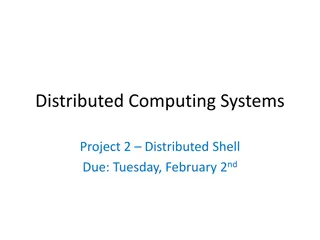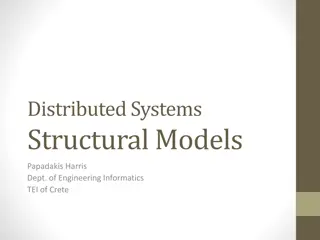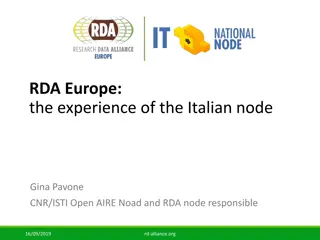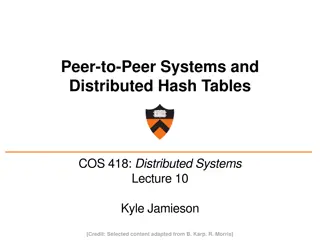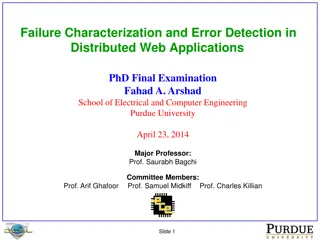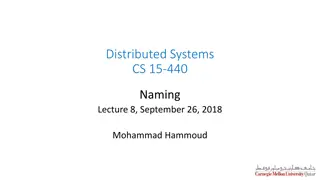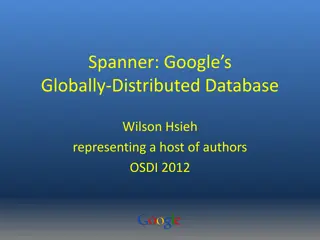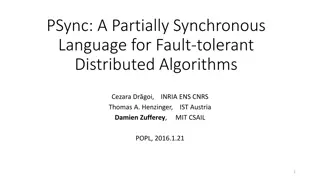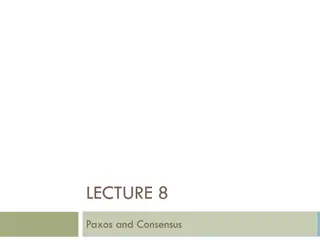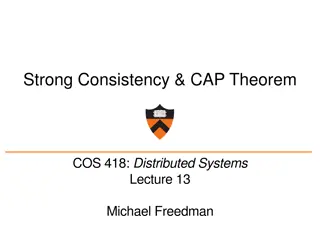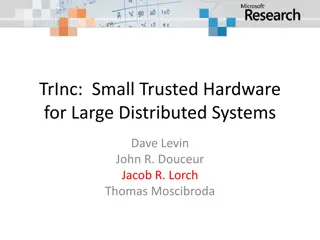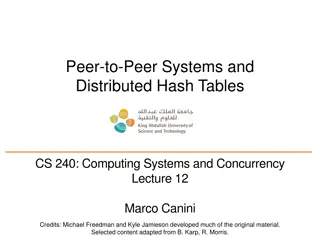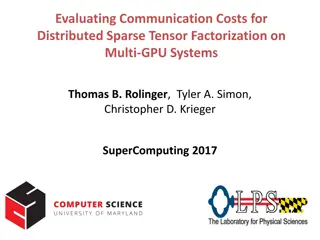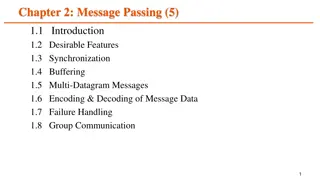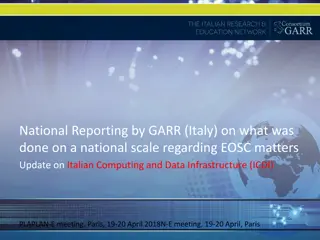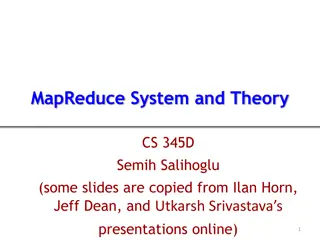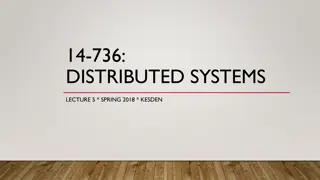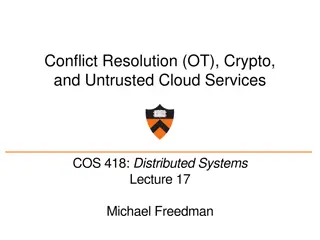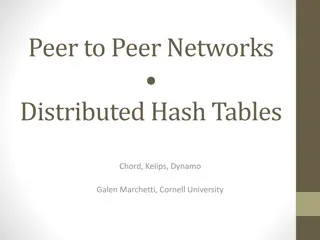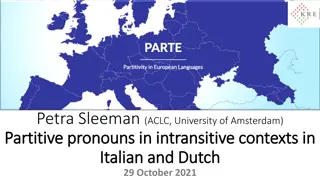Italian Model of Distributed Research Information Management Systems
The case study discusses the adoption of Dspace-CRIS in Italy, highlighting the benefits such as open repositories, enhanced metadata quality, and increased national research visibility. The integration of persistent identifiers like ORCID has improved data quality and interoperability. Lessons learned emphasize harmonization, open access support, PIDs for data quality, and the potential for significant research enabled by vast available data.
Download Presentation

Please find below an Image/Link to download the presentation.
The content on the website is provided AS IS for your information and personal use only. It may not be sold, licensed, or shared on other websites without obtaining consent from the author. Download presentation by click this link. If you encounter any issues during the download, it is possible that the publisher has removed the file from their server.
E N D
Presentation Transcript
The Italian model of distributed research information management systems: a case study Paola Galimberti & Susanna Mornati CRIS 2016, St-Andrews June 8-11
CRIS adoption in Italy 2006: two systems feeding the national database: UGOV Research and SURplus (55 installations) Critical issues: closed data (UGOV) Poor metadata and duplicated records No validation processes (poor quality of data) 2015: all installations migrated to IRIS, the new CRIS based on Dspace-CRIS, plus 11 new (total 66) Advantages: open repositories Richer metadata and shared records Validation processes and better quality Galimberti & Mornati, CRIS 2016
Benefits of country-wide adoption of Dspace-CRIS Dspace-CRIS is open source (independency from providers) CERIF compliancy (CERIF-XML import and export) Increased visibility of national research production (national harvester PLEIADI) Consistent data uploaded to the national database 3,5 million publications available in the Internet (10% with open-access full-text) More transparency for national research evaluation procedures Galimberti & Mornati, CRIS 2016
The persistent-identifier approach April 2015: the Italian National Evaluation Agency for University and Research announced ORCID mandatory June 2015: national agreement signed with ORCID September 2015: central Italian register (ORCID hub) launched November 2015: over 60,000 Italian researchers have an ORCID (> 90%) DSpace-CRIS is populated with ORCIDs but also with DOIs, Scopus IDs, WoS IDs, PubMed IDs, interoperable with Datacite, born to be interoperable with any external data source or target. Galimberti & Mornati, CRIS 2016
Lessons Learned The adoption of the same CRIS is a first step towards stronger harmonization The built-in open repository supports Open Access to publications and datasets Support for PIDs enhances data quality through disambiguation and contributes to a new architecture of research information infrastructure The huge amount of available data makes it possibile to conduct significant research and analysis Galimberti & Mornati, CRIS 2016
National Research Evaluation Exercises % of public funding on the basis of research performance: 2009 7% 2013 13,5% 2015 18 % Galimberti & Mornati, CRIS 2016
Research Questions Were the editorial choices of Italian researchers influenced by the criteria of the funding system? Can we register an improvement in the quality of the Italian research as a consequence of the national assessment? Galimberti & Mornati, CRIS 2016
Methodology Disciplinary areas (Italian Ministry classification): 05 Biology 10 Philology, Literature and Arts 11 Philosophy, Psychology and Pedagogy 12 Law 13 Political and Social Sciences Publications of Italian researchers from 2009 to 2014 Criteria: Impact Factor and IF location in percentiles for Biology, type of publication and language for HSS Source: CRIS of 66 Italian Universities Galimberti & Mornati, CRIS 2016
Biology - IF IF trends 2009-2014 71,008 items with IF and 54,281 items without IF # articles with IF stable, # articles without IF decrease Galimberti & Mornati, CRIS 2016
Biology IF location in percentiles Analysis of the distribution of IF value ranges shows that most articles are in the lower range and it does not change much over time Galimberti & Mornati, CRIS 2016
Results for Biology Moderate effects of the introduction of a Performance- Based Funding System where distribution of IF was one of the indicators Further investigation is necessary in other scientific areas (less influenced by DORA, the San Francisco Declaration on Research Assessment) Galimberti & Mornati, CRIS 2016
Disciplinary areas 10,11,12,14 Were opportunistic behaviours encouraged? Is the number of articles increased compared to the number of monographs? Area 10 Area 11 Area 12 Area 14 48.572 records examined 54.150 records examined 52.799 records examined 17.787 records examined Galimberti & Mornati, CRIS 2016
Results for type of contribution in HSS Clear decrease of the number of monographs Slight decrease in the number of book chapters except in area 12 (Law) Researchers tend to choose less time-consuming (better rewarding) formats (articles) Galimberti & Mornati, CRIS 2016
Internationalisation (use of English) Decrease in contributions written in Italian Increase in contributions written in English Even when the lingua franca is another language (Italian or other) Galimberti & Mornati, CRIS 2016
Critical issues For the first time in Italy a vast amount of data was available to analyse scholarly output not only in STM disciplines but also in HSS. Deduplication is provided at institutional level but not at national level, but we believe that on such a large scale the presence of duplicates has small influence on findings. Galimberti & Mornati, CRIS 2016
Conclusions Galimberti & Mornati, CRIS 2016 In Biology the number of publications in IF journal has not significantly changed over the last few year, while the number of thios published in journal without IF has decreased. Further investigations shoul be conducted in disciplines less influenced by the DORA. In HSS we observed a tendency to publish more journal articles and less monographs (more time-consuming and less rewarding in national evaluation criteria), and to publish more contributions in English (where internationalisation criteria were often confused with the mere use of the English language). Further research form CRIS data, in other disciplines and in other countries, should be encouraged.
Thank you very much for attention Corresponding author: paola.galimberti@unimi.it Galimberti & Mornati, CRIS 2016




